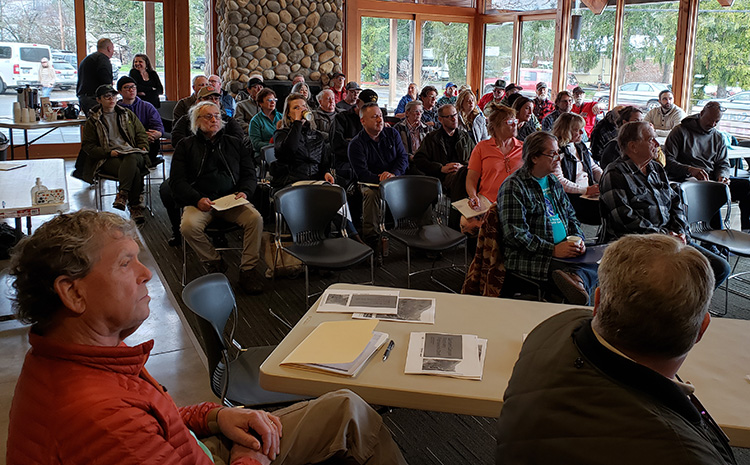Reporter for The Canyon Weekly
Approximately 100 households in the Santiam Canyon still are being case-managed by recovery officials as they look to rebuild. And economic development challenges remain all the way from Mill City to Detroit and Idanha as the region looks to generate the required sewer capacity.
But a sense of optimism pervaded the Gates Fire Hall on March 25, as the Marion County Board of Commissioners and elected officials from Gates and Detroit hosted a session on recovery from the 2020 wildfires that devastated the region.
It was a far cry from a similar session in Detroit in December in which frustration spilled over amid questions that did not yet have answers.
All the answers are not in yet, but the crowd of approximately 50 people at Saturday’s session were more inclined to thank the county and city officials and the Santiam Canyon Long Term Recovery Group (LTRG) for their efforts rather than complain about what hasn’t been done.
Although no formal vote was taken on the draft plan (see information box with the four key goals) community members as well as the elected officials in the room seemed to want to just move forward and take action where needed rather than continue to assess and reassess.
“There is no formalized structure,” said Marion County Commissioner Danielle Bethell, “we don’t have to vote on anything today. There is work still to be done and we don’t have any expectations that we are going to walk out of here and say this is final.”
Housing and sewer capacity continue to be the larger hills that the recovery train still needs to climb. And the housing piece involves more than just new construction, said consultant Sarah Reich.
“Remember, it’s also the housing that is no longer here,” she said, “and the housing that should have been here.”
The housing piece received a $12 million boost earlier this month from the Oregon Housing and Community Services (OHCS). Bethell said that the money just might enable Canyon communities to zero out the 92 households that are still being case-managed by the LTRG. That’s the good news.
The bad news is that the Legislature has long since OK’d the funding and county officials worked for nearly two years with OHCS on the rules that governed who received the assistance. The state agency wanted the income level to be at 80 percent of the area median. The commissioners held out for 120 percent, ensuring that more families would be eligible.
But the squabble took time and you could see the political scars at Saturday’s session.
“It’s the (legislators) in the Portland area that are the problem,” said Commissioner Colm Willis.
“It’s us against Portland,” said Commissioner Kevin Cameron. “We can’t get them to give a crap.”
“I have acted like a lunatic for two years running to get the state to help the county,” Bethell said. “It’s ridiculous.”
The housing piece runs hand in hand with the sewer challenge, and economic development follows in short order.
The good news here is the money, approximately $50 million, is in hand to install the North Santiam Sewer Authority’s Mill City to Gates line with a deadline of 2026 to spend it.
The bad news is that another $60 million is needed to connect to Detroit and Idanha.
Gates Mayor Brian Gander noted that there are people who want to rent in his town but without the sewer capacity the multifamily housing can’t be built. Detroit, meanwhile, lost most of its business district in the fires and timing will be everything as they look to both get their businesses back and build housing for the workers.
“Sewer capacity is essential for anything to happen in our business district,” said Detroit Councilor Denny Nielsen.
His compatriot, Eric Page, added that the housing and sewer components must come together at as close to the same time as possible.
“A guy is not going to invest $1 million in a brewery or a restaurant or a laundromat if there is no housing for the workers,” Page said.
The owners of the Mountain High Grocery, whose building survived in what is seen by many as a Detroit miracle, asked if they should build septic now to help them develop the reset of their property or wait for the sewers.
Cameron, who twice pessimistically noted that he does not expect to be alive when the Detroit sewer opens, vowed to find a way to help.
Bethell did the same with another audience member, who told one of those classic Canyon stories of a burned-out homeowner who gave up amid too many forms and applications and permits and being told “no” too many times.
“This is bad for everybody,” Bethell said, “perhaps the hardest thing you’ll ever have to do. Just call. We will rally a team around you, and if we can’t get a team together, I’ll come up here myself.”
RECOVERY GOALS
Here are the four goals that are part of the proposed Santiam Canyon wildfire recovery plan put together by consultants working with Marion County and Canyon officials.
• Formalize coordination efforts and technical support
• Support workforce and affordable housing
• Streamline sewer/septic permitting process
• Collaborate on expanding and integrating recreation
NORTH FORK MEETINGS
The Marion County Board of Commissioners will meet with the public to discuss parks restoration in the North Fork area. The first meeting is Wednesday, April 5 at the Elkhorn Fire Department. The second is Tuesday, April 11 at the community center in Mehama. Both meetings are at 6 p.m. and open to the public.






